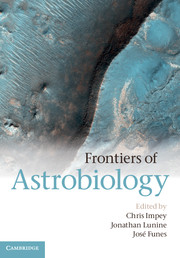Book contents
- Frontmatter
- Contents
- List of contributors
- Part I Introduction
- Part II Origin of Planets and Life
- Part III History of Life on Earth
- Part IV Habitability of the Solar System
- Part V Exoplanets and Life in the Galaxy
- 11 Searches for Habitable Exoplanets
- 12 Review of Known Exoplanets
- 13 Characterizing Exoplanet Atmospheres
- 14 If You Want to Talk to ET, You Must First Find ET
- Index
- Plate Section
- References
11 - Searches for Habitable Exoplanets
from Part V - Exoplanets and Life in the Galaxy
Published online by Cambridge University Press: 05 December 2012
- Frontmatter
- Contents
- List of contributors
- Part I Introduction
- Part II Origin of Planets and Life
- Part III History of Life on Earth
- Part IV Habitability of the Solar System
- Part V Exoplanets and Life in the Galaxy
- 11 Searches for Habitable Exoplanets
- 12 Review of Known Exoplanets
- 13 Characterizing Exoplanet Atmospheres
- 14 If You Want to Talk to ET, You Must First Find ET
- Index
- Plate Section
- References
Summary
Introduction
For thousands of years people have wondered about the existence of habitable worlds. We frame the discussion in terms of a hierarchical series of ancient questions: “Do other Earths exist?” and “Are they common?” and “Do any have signs of life?” With hundreds of known exoplanets of increasingly smaller mass and size, we are on the verge of answering these questions. Thousands of years from now, people will look back and see as one of the most significant, positive accomplishments of our early twenty-first century society the first discoveries of exoplanets, and the human foray into finding and characterizing habitable worlds.
How to discover Earths
Do other Earths exist? Our Galaxy, the Milky Way, has about 100 billion stars. The universe has upwards of 100 billion galaxies. The chance therefore that another Earth exists is extremely high, even if Earths are rare.
Finding Earths to confirm their logical existence, however, is another matter. We will not believe that other Earths exist until we have robust evidence. The biggest challenge in detecting another Earth is that Earth-like planets are miniscule compared to their adjacent parent star. Our own Earth is so much smaller than the Sun (100 times), so much less massive (1000 times), and so much less bright (107–1010, depending on wavelength). Any planet-detection technique (see Figure 11.1) is challenged to find another Earth.
- Type
- Chapter
- Information
- Frontiers of Astrobiology , pp. 231 - 249Publisher: Cambridge University PressPrint publication year: 2012

